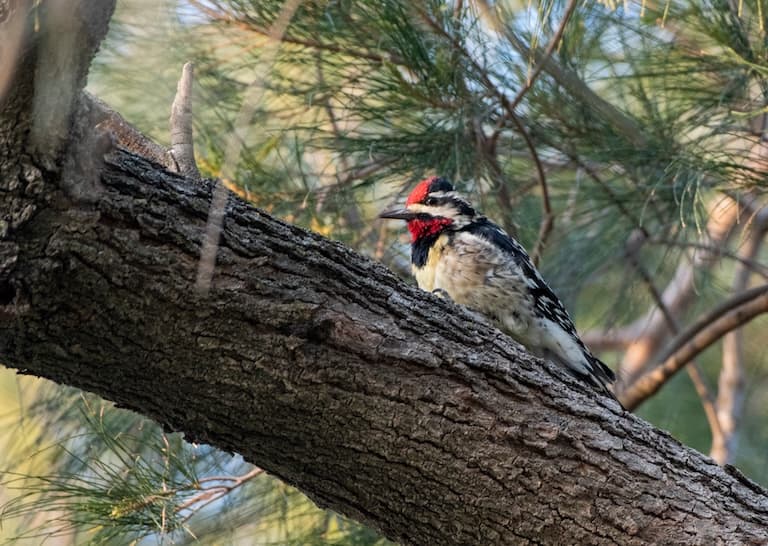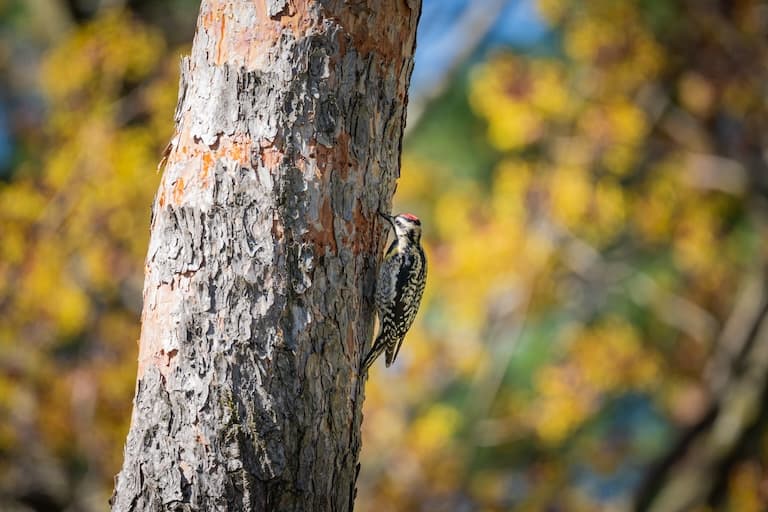Yellow-bellied Sapsucker Profile
There are few animals with a name as insulting as this one. Whichever way you look at it, this bird is just unfortunate. And the fact that it’s a woodpecker doesn’t make things any better.
It’s not even a very big woodpecker.
But in this piece, we’re going to try and find what’s behind the name, and give a voice to a bird that deserves more.

Yellow-bellied Sapsucker Facts Overview
| Habitat: | Woodland: deciduous and mixed coniferous forests in summer, forests and various semi-open habitats in Winter. |
| Location: | Canada, Alaska, NW USA, occasionally in Northern Europe; overwinters as far South as Central America. |
| Lifespan: | Up to around 6 years |
| Size: | 21 cm (8 inches) long |
| Weight: | 55g (2 oz) |
| Color: | Black back, white rump, yellowish breast; males have red throats |
| Diet: | Mostly insects: beetles, ants, moths and dragonflies; sap as a secondary source when insects are not around |
| Predators: | Raccoons, squirrels |
| Top Speed: | Unknown |
| No. of Species: | 1 |
| Conservation Status: | Least Concern |
The yellow-bellied sapsucker is far from cowardly. This is an animal that uses its own face to break into trees and kill things.
And when Spring comes along, it lives life on hard mode, rearing its furiously entitled sucklets from farm to table in just a matter of weeks.
Interesting Yellow-billed Sapsucker Facts
1. They’re probably not cowards
The “yellow-bellied” insult has a bit of a murky origin, with the earliest records of its use seeming to appear in 16th Century England. By the time it got to the Americas in the 18th Century it was quickly adopted as a racist term for Mexicans. Sucker isn’t as bad as you might think, and has its roots in the late 14th Century, referring to an unweaned mammal.
Being neither English, Mexican, nor Mammal, none of these words really apply, and even when taken literally they’re a bit – to use another 16th Century phrase – fast and loose with the truth.
Yellowbellied sapsuckers are, a but yellow. But it’s faint, and as their scientific species name varius alludes to, their appearance can vary quite a lot. Their bellies are typically off-white, leaning into a feint yellow colour, and really not starkly enough to warrant the name at all,m and this is even before you consider that a woodpecker’s belly is almost always obscured by the tree it’s facing.
More than likely, this nickname was given to the bird to separate it from its more popular relations; namely the red-naped sapsucker and the hairy woodpecker.
As for being sapsuckers, this is only partly true, as they mostly get their food from insects, as do most woodpeckers.

2. They’re methodical
Sapsucker holes in trees aren’t typically cavernous or really all that damaging to the tree itself, at least in the Winter. This bird’s foraging attempts result in rows, between which the bird will alternate as it moves horizontally around the trunk, sipping from each one.
This is what the more southerly states associate with this species, as they are more than likely doing their sapsucking during Winter, when they’ll migrate south and struggle to find insects.
By May, they’ll be back up in Canada and the very northerly regions of the US, running pest control in the forests1.

3. They have special tongues
This species, like all woodpeckers, has a long tongue that’s connected to the top of the skull. This is pretty cool already, but as a sapsucker, the other end of this extremely long tongue is designed as a sort of basting brush to increase surface area for collecting the sticky juice.
This fluffy tongue is a variation on the barbed tonge that many other woodpeckers have, which is more specialised for insects.
But as we mentioned already, the sapsucker still does get most of its calories from bugs, especially when it’s breeding. And this is, in part down to how demanding its offspring are.
4. They have high maintenance babies
Breeding holes made in trees by this species are far more invasive. From April to May, these birds are excavating large birthing chambers up to 20 metres up the trunk of a tree – usually an aspen – and breeding pairs will both take part in this construction.
Then, they’ll reinforce their bonds by courting and singing to one another and banging their heads against the tree. They’ve already chosen each other as mates, so this isn’t a test of fitness, it’s merely the psychological prep work required to remind one another they’re supported through what will be a very intense parenting season.
A quick tumble in the hay results in around five eggs being laid which hatch in less than two weeks.
The parents have less than a single month to fledge these rapidly-growing babies, who, in turn, require feeding nine times an hour for the duration.
So, it’s pretty flat out for a while, during which the parents are frantically trying to stay on top of their own caloric requirements, while removing the copious amounts of baby guano and feeding their entitled little bird brats 216 times a day.

5. Their tongues help with this, too.
Aside from the brush at the tip, yellow-bellied sapsuckers also have rearward-facing spines along the sides of the tongue to help catch their insect prey.
Beetles, ants, moths and dragonflies are at the top of the menu for this species, and some suggest that the drying sap from their wells also acts as a sticky trap for their food, but this is difficult to confirm.
6. They’re drummers
The feeding and nesting trees these birds use are very much alive at the time. But there’s a common behaviour in this species that involves very dead trees, too.
In fact, anything that reverberates loudly can be used by a sapsucker as a drum, which is usually a dear tree, but can also be an aluminium ladder, a rain gutter, or a politician’s head.
Nobody seems quite sure why they do this, but it’s likely some sort of long-distance communication. Unfortunately, we’re still woefully ignorant as a species, of what birds are saying in general, so that’s about the extent to which we can guess.
It’s more intense during breeding season, so it’s likely something to do with the quality and condition of the animal’s loins during this period2, but why they do it during the rest of the year is still the topic of someone’s future PhD.
Yellow-bellied sapsucker Fact-File Summary
Scientific Classification
| Kingdom: | Animalia |
| Phylum: | Chordata |
| Class: | Aves |
| Order: | Piciformes |
| Family: | Picidae |
| Genus: | Sphyrapicus |
| Species Name: | Varius |
Fact Sources & References
- Sue Watts (2025), “A Backyard Encounter with the Yellow-Bellied Sapsucker”, Home and Garden Information Center.
- Lawrence Kilham (1962), “Breeding Behavior of Yellow-Bellied Sapsuckers”, Ornithology .
